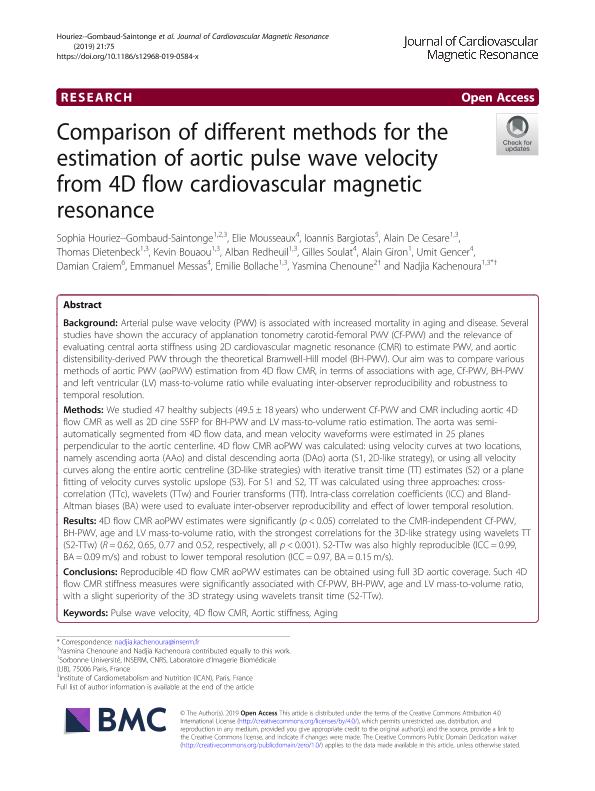Artículo
Comparison of different methods for the estimation of aortic pulse wave velocity from 4D flow cardiovascular magnetic resonance
Houriez Gombaud-Saintonge, Sophia; Mousseaux, Elie; Bargiotas, Ioannis; De Cesare, Alain; Dietenbeck, Thomas; Bouaou, Kevin; Redheuil, Alban; Soulat, Gilles; Giron, Alain; Gencer, Umit; Craiem, Damian ; Messas, Emmanuel; Bollache, Emilie; Chenoune, Yasmina; Kachenoura, Nadjia
; Messas, Emmanuel; Bollache, Emilie; Chenoune, Yasmina; Kachenoura, Nadjia
 ; Messas, Emmanuel; Bollache, Emilie; Chenoune, Yasmina; Kachenoura, Nadjia
; Messas, Emmanuel; Bollache, Emilie; Chenoune, Yasmina; Kachenoura, Nadjia
Fecha de publicación:
12/2019
Editorial:
BioMed Central
Revista:
Journal of Cardiovascular Magnetic Resonance
ISSN:
1097-6647
e-ISSN:
1532-429X
Idioma:
Inglés
Tipo de recurso:
Artículo publicado
Clasificación temática:
Resumen
Background: Arterial pulse wave velocity (PWV) is associated with increased mortality in aging and disease. Several studies have shown the accuracy of applanation tonometry carotid-femoral PWV (Cf-PWV) and the relevance of evaluating central aorta stiffness using 2D cardiovascular magnetic resonance (CMR) to estimate PWV, and aortic distensibility-derived PWV through the theoretical Bramwell-Hill model (BH-PWV). Our aim was to compare various methods of aortic PWV (aoPWV) estimation from 4D flow CMR, in terms of associations with age, Cf-PWV, BH-PWV and left ventricular (LV) mass-to-volume ratio while evaluating inter-observer reproducibility and robustness to temporal resolution. Methods: We studied 47 healthy subjects (49.5 ± 18 years) who underwent Cf-PWV and CMR including aortic 4D flow CMR as well as 2D cine SSFP for BH-PWV and LV mass-to-volume ratio estimation. The aorta was semi-automatically segmented from 4D flow data, and mean velocity waveforms were estimated in 25 planes perpendicular to the aortic centerline. 4D flow CMR aoPWV was calculated: using velocity curves at two locations, namely ascending aorta (AAo) and distal descending aorta (DAo) aorta (S1, 2D-like strategy), or using all velocity curves along the entire aortic centreline (3D-like strategies) with iterative transit time (TT) estimates (S2) or a plane fitting of velocity curves systolic upslope (S3). For S1 and S2, TT was calculated using three approaches: cross-correlation (TTc), wavelets (TTw) and Fourier transforms (TTf). Intra-class correlation coefficients (ICC) and Bland-Altman biases (BA) were used to evaluate inter-observer reproducibility and effect of lower temporal resolution. Results: 4D flow CMR aoPWV estimates were significantly (p < 0.05) correlated to the CMR-independent Cf-PWV, BH-PWV, age and LV mass-to-volume ratio, with the strongest correlations for the 3D-like strategy using wavelets TT (S2-TTw) (R = 0.62, 0.65, 0.77 and 0.52, respectively, all p < 0.001). S2-TTw was also highly reproducible (ICC = 0.99, BA = 0.09 m/s) and robust to lower temporal resolution (ICC = 0.97, BA = 0.15 m/s). Conclusions: Reproducible 4D flow CMR aoPWV estimates can be obtained using full 3D aortic coverage. Such 4D flow CMR stiffness measures were significantly associated with Cf-PWV, BH-PWV, age and LV mass-to-volume ratio, with a slight superiority of the 3D strategy using wavelets transit time (S2-TTw).
Palabras clave:
4D FLOW CMR
,
AGING
,
AORTIC STIFFNESS
,
PULSE WAVE VELOCITY
Archivos asociados
Licencia
Identificadores
Colecciones
Articulos (IMETTYB)
Articulos de INSTITUTO DE MEDICINA TRASLACIONAL, TRASPLANTE Y BIOINGENIERIA
Articulos de INSTITUTO DE MEDICINA TRASLACIONAL, TRASPLANTE Y BIOINGENIERIA
Citación
Houriez Gombaud-Saintonge, Sophia; Mousseaux, Elie; Bargiotas, Ioannis; De Cesare, Alain; Dietenbeck, Thomas; et al.; Comparison of different methods for the estimation of aortic pulse wave velocity from 4D flow cardiovascular magnetic resonance; BioMed Central; Journal of Cardiovascular Magnetic Resonance; 21; 1; 12-2019; 1-13
Compartir
Altmétricas



